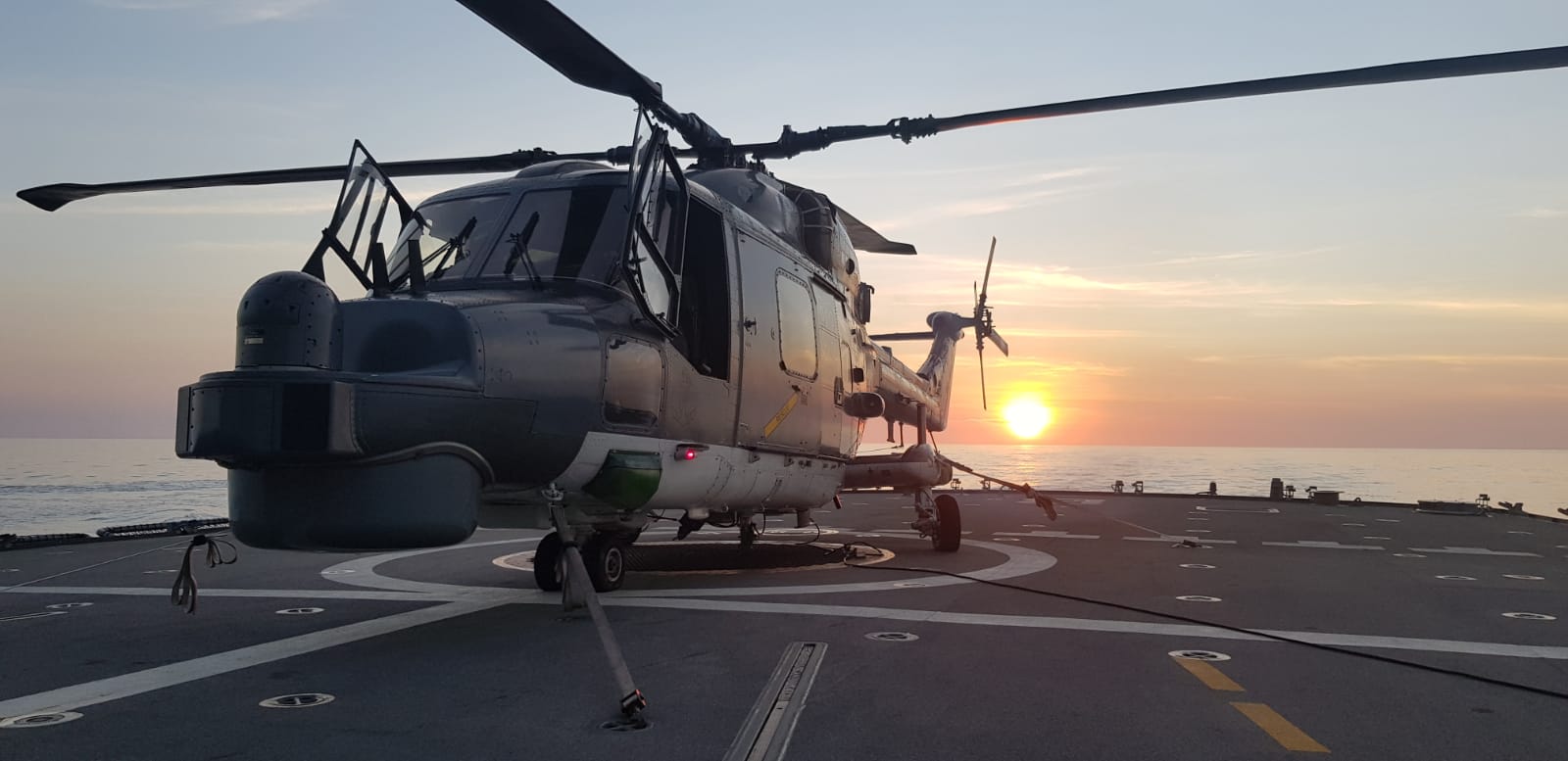Error Management part 3 - Maintain aircraft control, analyze situation, take proper action

It was again one of those flights that were ill-fated. A night low-flying training flight in the German Bight was planned. The weather wasn't great, not good, but not bad enough to make a clear decision for us. A weather prediction that made my decision, as the responsible flight instructor, once again well-earned money. To fly or not to fly was the question here. My student was already experienced, the training syllabus was pushing and we were eager to get going, so I decided to go flying. As it is so often the case, the decision was accompanied by the statement "we'll give it a try".....Situational awareness and decision making were the main elements of our "Management Framework" CRM - Crew Resource Management. The situation was not brilliant, but, considering all the information, acceptable - a calculated risk. My student was happy, I was happy.
It was autumn time and the sun set early again in November this year, so the take-off was planned for a reasonably early time in the evening. After 2 hours of flight time we were to return to the airfield. That was the plan.
The further preparation followed the normal procedure and we were able to start the engines as planned. 10 minutes later we went airborne.
The northern departure route was in the direction of the Elbe fairway, to give my student the opportunity to practice some low-level flight following the fairway and to warm up. The weather appeared as predicted, not brilliant but good enough. Good enough for government work as we used to say.
So we followed the fairway in the direction of Elbe 1 and, after passing the Elbe 1 buoy, began the actual flight content.
The course of the flight was as expected and the time literally flew by.
Returning home - when things started to go down the drain
After a good 90 minutes it was time to take us back home. Especially with these weather conditions, it makes sense to plan some "air" for the unforeseen. So we made our way home towards the coastline. The closer we got to the shoreline, the worse the weather conditions got, the visibility got less and less and the clouds hung unexpectedly low, so that we finally found ourselves about 200 feet above the ground. The radar told me clearly where the shoreline was and when it was time to make the necessary checks and to communicate with the control tower.
My student was still the pilot-flying while I took care of navigation, radar and most importantly communications, as I had for the past 2 hours. For 2 hours I had my eyes on the instruments, on the radar image or outside in the dark night, but I wasn't actually flying hands-on.
For the pilot, night low level flight over sea means flying according on instruments only. Other than the day when you have your eyes outside. This type of flying, 100 feet above the water surface at night and in bad weather, requires maximum focus and does not forgive any mistakes. In this way, we also avoid switching controls between pilots as much as possible. Apart from that, my student should get as much “sticktime” - actually flying hands-on - as possible.
Maintain aircraft control, analyze situation.....
At 200 feet we were now entering the clouds, which is not a good idea so close to the shoreline with obstacles rising above 200 feet. The risk of flying into those was immense. With my student flying, I had my focus on the communication and the radar image and neither I nor my student noticed the steadily falling cloud base. When I saw in the corner of my eye that we were entering the clouds, de facto already above the coastline, I reflexively took control of the aircraft, initiated a left turn and descended to get out of the clouds. Let's remember that at this point we were less than 200 feet above the ground.
So far so good and everything is controllable if, yes, if I had looked at the flight instruments and not, as happened, out of the cockpit window where there was no visual clue or reference as to our attitude and altitude. There wasn't much to see apart from darkness and my spatial disorientation was complete. I still remember seeing the radar altimeter as the needle went through 50 feet. My years of training kicked in abruptly and I pulled on the collective to gain height while leveling the “wings” to resume normal attitude…..after felt ages - in fact split seconds - got the aircraft back under control with a max power climb, wings level. Heart pounding and knees shaking we made it….so far. We must not have been a split second from hitting the dike west of the airfield kissing ourselves goodbye. In a few seconds we had slipped from a stable flight condition into a "near crash". I struggled with my sensory impressions and my sense of spatial orientation. This was completely out of joint and was telling me something that was not consistent with the instruments.
If in doubt, apply the basics
If in doubt, the flight instruments are always correct. "Have faith" it said in my head. So “back to basics” and set up the instrument scan….
That's how I managed to get the aircraft into a stable flight condition and stay off the ground...we carefully and safely ascended back into the deep darkness we had just come from. Reaching 150 feet above ground I saw in the right corner of my eye a bright beam of light stretching straight up into the sky....which I came to call the “Finger of God”. This bright beam gave me visual orientation in space again and I was able to realign my feelings with the instruments. I gently banked the aircraft to the right toward the beam of light, being mindful not to get into the next spatial disorientation. It was the outer edge of the spa areas south of Cuxhaven that were still lit up at that time and, in combination with the heavy rain, led to this phenomenon that was anchored in my memory as "Finger of God" from then on.
Stable at 100 feet to stay below clouds, we flew slowly along the coastline towards Cuxhaven, hoping to be able to reach the field from the north. As it quickly turned out, it was a naïve hope so that we finally were forced to make an emergency landing in the port of Cuxhaven due to the bad weather conditions. After the whole odyssey we were running low on fuel and a double engine failure due to fuel starvation was the last thing we needed at this point. The set up for a landing at night in the middle of the Cuxhaven port area was completed and my student and I were back in the game. The landing itself was uneventful, especially with the prehistory. Safe on the ground we breathed a sigh of relief.
What happened?
I made a fundamental mistake. In a critical moment I forgot my basic knowledge and skills that a pilot learns and internalizes in the first flight lessons. Maintain aircraft control, analyze situation and take proper action. I neither kept the aircraft under control, nor did I correctly assess the situation and I also did not take the right measures. I rushed to take control of the aircraft without being prepared and ready. No instrument scan set up, I "blew" myself into spatial disorientation along with the left turn not noticing the rate of descend, losing control of the aircraft and building up a sink rate that should have led to an impact at this low altitude. Luckily it did not! I almost managed to not only kill me - again - but also my student. Your worst nightmare almost came true.
How could this happen?
At the time of this flight I had many years of experience as a flight instructor, had trained dozens of pilots and mastered many critical situations. And yet something was different. I had hardly flown this profile myself in the months leading up to this flight, was completely occupied with other, mostly tactical training flights, and lost what we call my currency. The “practice” if you will. During this time, we introduced a new type of our aircraft and I was one of the two flight instructors who created and carried out the entire training on this type. In addition, there was hardly any time for the “other” sort of aviation.
So it happened that, when it mattered most, I was unable to recall and apply what I had learned. I lacked the practice and also forgot the three basics in an emergency
- Maintain aircraft control
- analyze situation
- take proper action
Three simple actions that save your life when in doubt
I was lucky that once again it seemed as if my time wasn't there yet.
Lesson learned?
What does all this have to do with error management? Good question!
In the fourth and concluding part of this series on error management, I will summarize and establish a connection to today's organizations and error culture.
One thing can already be revealed at this point, I continued to fly after that night and my mistakes were not sanctioned. However, I drew my personal conclusions and did not fly any of these training flights as a flight instructor until I was “current” again and felt comfortable.
Food for thought!
.



